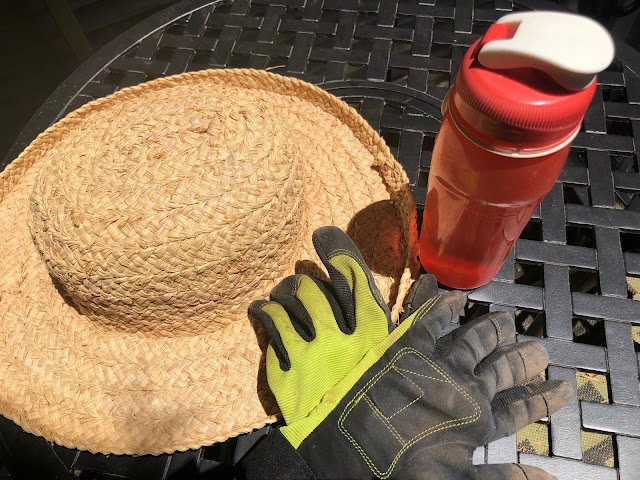
Take master gardeners' advice to protect against heat-related illnesses
 |
|
Heat can make you sick! Take precautions -- like wearing a hat
and having plenty of water nearby -- when gardening. (Photo: Kathy Morrison) |
A little sweat is one thing; heat exhaustion (or worse) can send you to the hospital.
Heat represents a real danger to gardeners. That’s important to remember during this string of triple-digit days.
When there’s work to be done, we’re tempted to tough it out and ignore our body’s warning signs. That’s a bad idea. According to the Centers for Disease Control and Prevention, an average of 658 Americans die each year due to extreme heat – despite the fact that all those deaths and illnesses are preventable.
As part of its master gardener training, the UC Cooperative Extension came up with these reminders and tips. They’re helpful to review before going out in this heat.
What are common heat illness disorders and symptoms?
1. Heat Stroke: Sweating stops and the body fails to regulate its temperature. Victims may die if they don’t receive immediate medical treatment. Characterized by: mental confusion, fainting, or seizures; hot dry skin usually reddish in color; and high body temperature.
Treatment: Call 911 immediately, soak victim’s clothing with cool water, move victim to shaded and cool area, fan victim to increase cooling of their body.
2. Heat Exhaustion: Profuse sweating results in dehydration. Characterized by: fatigue, dizziness and nausea; pale and moist skin; and possibly slightly elevated temperature.
Treatment: Have victim rest in shaded and cool place and drink fluids. Do not serve caffeinated fluids such as soft drinks, iced tea, or coffee.
3. Heat Cramps: Cramping thought to be due to loss of salt through sweating. Characterized by muscle spasms in arms, legs and abdomen during or following physical activities.
Treatment: Have victim rest and drink non-caffeinated fluids.
4. Heat Syncope: Dehydration while standing still causes blood pooling in lower portions of the body. Characterized by fainting while standing still.
Treatment: Have victim rest in a shaded and cool place, and drink non-caffeinated fluids.
5. Heat Rash: Occurs under hot and humid conditions where sweat does not evaporate readily. Characterized by irritated or itchy skin with prickly feeling and small red bumps on skin.
Treatment: Wash and dry skin. Wear loose clothing and keep skin dry.
Here are master gardener tips to prevent heat-related illnesses:
1. Gardeners should acclimatize themselves to the prevailing weather conditions.
2. Always drink plenty of fluids such as water and sports drinks. During warm weather, plan to have at least one quart of water available per person per hour of the outdoor activity. Avoid caffeinated drinks.
3. Wear a summer hat with a brim, and loose-fitting, light-colored and lightweight clothing.
4. Schedule vigorous activities during coolest portions of the day and take frequent breaks on hot days.
5. If someone is feeling symptoms of heat illness, they should take a rest period in a shaded area. If a treated victim does not recover from heat illness in a reasonable amount of time, promptly seek medical attention.
Comments
0 comments have been posted.Sacramento Digs Gardening to your inbox.
Sites We Like
Garden Checklist for week of May 5
Survey your garden after the May 4 rainstorm. Heavy rain and gusty winds can break the neck of large flowers such as roses. Also:
* Keep an eye on new transplants or seedlings; they could take a pounding from the rain.
* Watch out for powdery mildew. Warmth following moist conditions can cause this fungal disease to “bloom,” too. If you see a leaf that looks like it’s dusted with powdered sugar, snip it off.
* After the storm, start setting out tomato transplants, but wait on the peppers and eggplants (they want warmer nights). Pinch off any flowers on new transplants to make them concentrate on establishing roots instead of setting premature fruit.
* Trim dead flowers but not leaves from spring-flowering bulbs such as daffodils and tulips. Those leaves gather energy to create next year's flowers. Also, give the bulbs a fertilizer boost after bloom.
* Pinch chrysanthemums back to 12 inches for fall flowers. Cut old stems to the ground.
* Mulch around plants to conserve moisture and control weeds.
* From seed, plant beans, beets, cantaloupes, carrots, corn, cucumbers, melons, pumpkins, radishes and squash.
* Plant onion sets.
* In the flower garden, plant seeds for asters, cosmos, celosia, marigolds, salvia, sunflowers and zinnias. Transplant petunias, zinnias, geraniums and other summer bloomers.
* Plant perennials and dahlia tubers for summer bloom.
* Don’t wait; plant summer bulbs, such as gladiolus and tuberous begonias.
* Harvest cabbage, lettuce, peas and green onions.